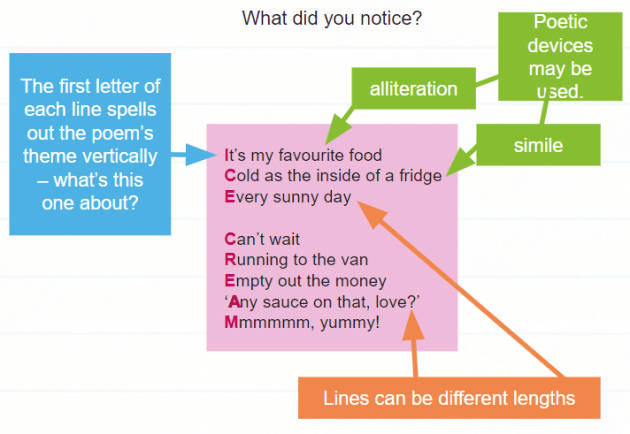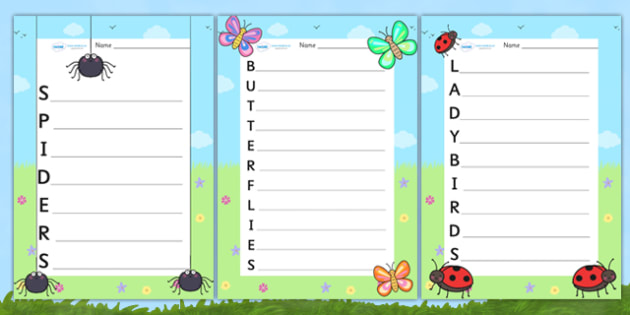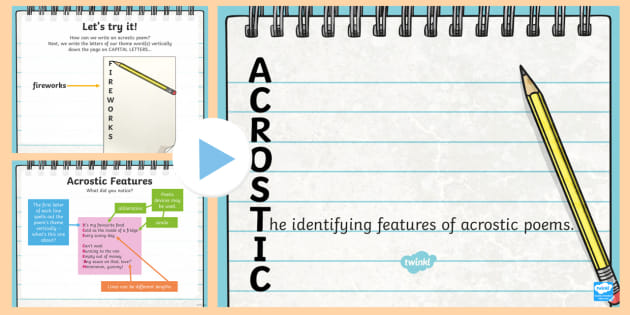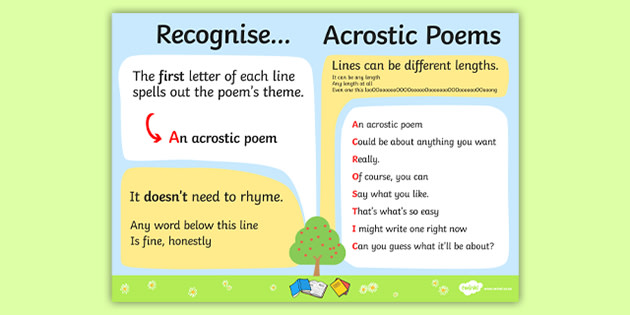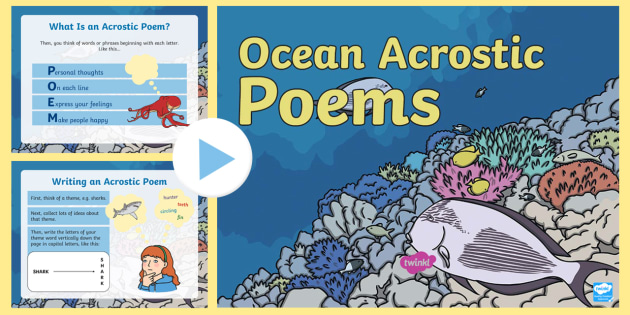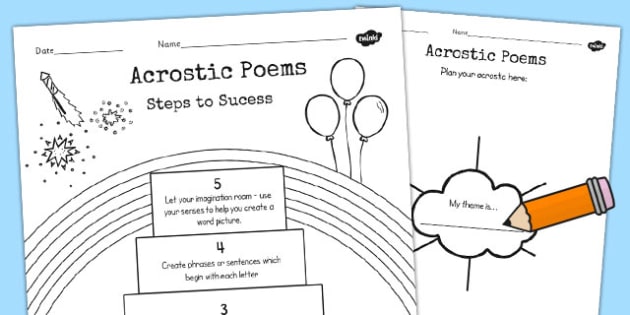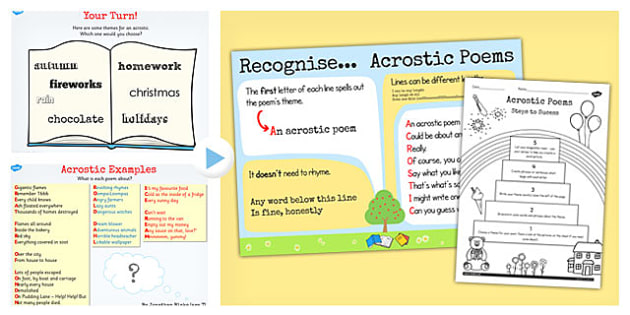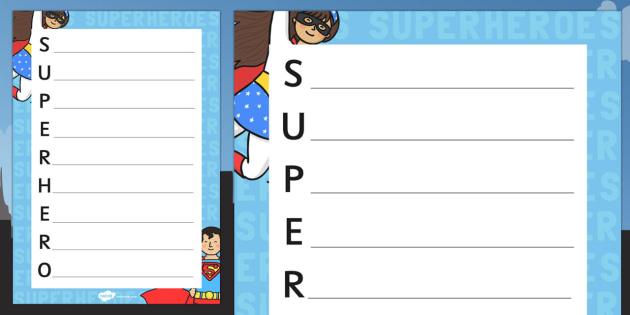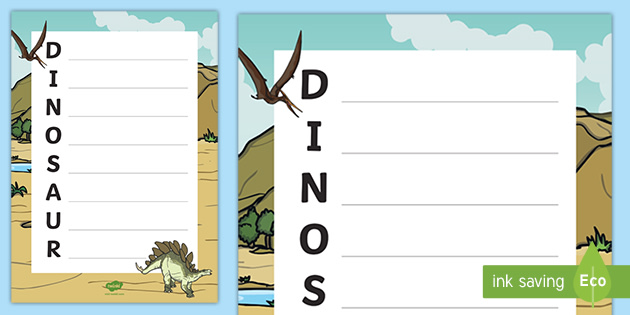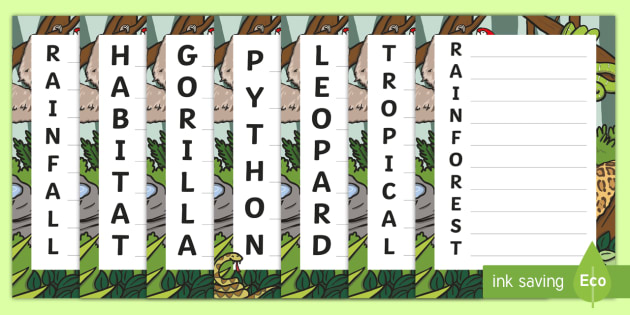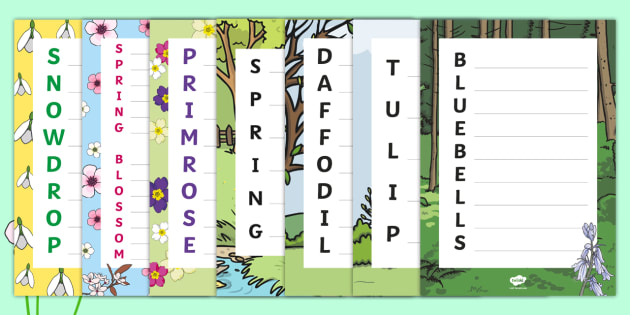
What is an Acrostic Poem?
Acrostic Poem

What is an Acrostic Poem?
An acrostic poem is a poem in which certain letters of each line spells out a word, name, or phrase when read vertically. Most often, it's the first letter of each line that spells out the word, but they can be placed anywhere on the line. When they're placed elsewhere in the line, it forms a kind of hidden 'code'.
Children may be taught about acrostic poems during primary school, and they can be a fun, engaging activity during English lessons.
Acrostic Poem Features
Each line starts with a capital letter that spells out the poem's theme vertically.
Like any poem, acrostic poems don't need to rhyme, but all the other poetic devices like alliteration, similes and rhythm can be used in them too.
How do you write an Acrostic Poem?
Writing acrostic poems is fun, and it's a fantastic way for children to be creative while boosting their writing skills at the same time. To write your own acrostic poem, follow these easy steps:
-
Decide what you want to write about.
Sometimes, deciding what you want to write about can be the hardest part! Children can start by writing down things they like, such as their favourite animal, favourite food, or even a favourite video game. They should narrow it down to the one they want to write about the most.
-
Write down your word vertically.
The next step is to prepare for writing out your poem. Once you've chosen a word to use, write it down vertically, like this, for example:
There should be enough space next to each letter to write a full line.
-
Mind map your ideas.
Once you've got your main topic down, it's time to mind map ideas. Children should write down their main topic on a different piece of paper and surround it with ideas that they might write about, such as adjectives to describe the topic or similes if they want to be really creative.
-
Use your ideas to fill the poem.
Take a look at the ideas you noted down earlier. Find words that start with each letter of your chosen word. Write these words next to each letter. If you don't have a word for each letter yet, don't worry - you can always think of one later.
-
Fill in the rest of your poem.
With the basics of the poem filled out, it's time to fill in the rest of the poem! Use the words you've got as inspiration and let the words flow.
Acrostic Poem Examples
Acrostic poems can be about anything. The rule to remember is a letter of each line needs to help spell your poem's theme. Here are examples when the first letter is used to spell out the theme:
It's my favourite food
Cold as the inside of a fridge
Every sunny day
Can't wait
Running to the van
Empty out the money
Any sauce on that, love?
Mmmmmm, yummy!
This acrostic poem about Roald Dahl is another example.
Revolting rhymes
Oompa-Loompas
Angry farmers
Lazy aunts
Dangerous witches
Dream blower
Adventurous animals
Horrible headteacher
Lickable wallpaper
Here are examples when the letter is placed in other parts of the line:
Tail up to the sky
Walking Into the jungle
Soft paws, Giant teeth
It's time to Eat
Before the delicious prey Runs
And another example:
A comfy coucH
A fruit bowl filled with apples and mangO
Upstairs is my bedrooM
My favourite placE
Famous Acrostic Poems
Here are some famous acrostic poems written by poets:
An Acrostic, by Edgar Allen Poe
Elizabeth it is in vain you say
"Love not" — thou sayest it in so sweet a way:
In vain those words from thee or L.E.L.
Zantippe's talents had enforced so well:
Ah! If that language from thy heart arise,
Breathe it less gently forth — and veil thine eyes.
Endymion, recollect, when Luna tried
To cure his love — was cured of all beside —
His follie — pride — and passion — for he died.
This acrostic poem by Poe spells out 'Elizabeth', who he writes about in the poem.
Acrostic, by Lewis Carroll
Little maidens, when you look
On this little story-book,
Reading with attentive eye
Its enticing history,
Never think that hours of play
Are your only HOLIDAY,
And that in a HOUSE of joy
Lessons serve but to annoy:
If in any HOUSE you find
Children of a gentle mind,
Each the others pleasing ever—
Each the others vexing never—
Daily work and pastime daily
In their order taking gaily—
Then be very sure that they
Have a life of HOLIDAY.
This acrostic poem by Carroll spells out the three names of the 'little maidens' - 'Lorina', 'Alice' and 'Edith'.
Interesting facts about acrostic poems
-
Acrostic poems were created by writers thousands of years ago.
-
There are pieces of evidence that state the acrostic poem was also written by Latin and ancient Greek writers. Some acrostic poems have been written by monks and poets during the Renaissance.
-
An acrostic poem in which the first letter of each line spells out the alphabet is called 'abecedarius'.
-
Some abecedarius poems can be found in the Bible
-
The Dutch national anthem is, in fact, an acrostic. The first letters spell Willem Van Nassov, the hereditary titles of the Stadtholder and King William of Orange. He used this trick to introduce himself to the Dutch people.
-
Some poets have written double and even triple acrostics poems. In a double acrostic poem, the word or message is formed by the first and last letter of each line. In a triple acrostic poem, the word is formed by the first, middle and last letter of each line.
How to teach Acrostic Poems to children
If you're teaching acrostic poems to your class, then you'll be glad to know that we have a wide selection of resources to support you and to get your pupils excited about poetry. Here's some to get you started:
Acrostic Poem PowerPoint
Introduce your pupils to acrostic poems by using this handy PowerPoint. It covers the features of acrostic poems as well as examples. This is a brilliant tool for whole-class teaching.
Recognise Some Different Forms of Poetry Acrostics Poster
This poster is a fantastic visual aid for your classroom. It shows an example of an acrostic poem and a definition of what an acrostic poem is.
Writing an Acrostic Poem Self-Assessment Tracker
Let your children assess their work with this amazing self-assessment resource. Ask them to write an acrostic poem, and in the meantime print a copy of this sheet for each one of them.
After they finish the task, hand them the sheet and encourage them to answer the questions to see how well they understood the topic. They'll have to consider the main features of an acrostic poem and rate themselves on their use of this feature.
Acrostic Name Poems
An excellent resource for young children learning about acrostic poems for the first time. Children can write their names down vertically, leaving space for a word next to each letter. Encourage them to choose words that they associate with themselves, so it's more personal.
Ocean Acrostic Poem PowerPoint
This handy PowerPoint can be a fantastic starting point for learning acrostic poems. The resource features eight fantastically illustrated slides that address key questions about this topic. Children will find the answer to: 'What is an acrostic poem?' and 'How do you write an acrostic poem?'.
Acrostic Poems Planning Sheet
This planning sheet is a great tool for children to use when it comes to writing their own acrostic poem. It gives them five steps for success and there's a sheet where they can write down their theme, and surround it with all their ideas.
Worm Acrostic Poem Worksheet
With this worksheet, children will have to think of all words that can describe worms, use alliteration and adjectives to describe them and note them down in the space provided. Then they’ll have to use the words they come up with and create a worm acrostic poem. The resource is a simple PDF file that can be easily downloaded and printed, so you can start the activity in minutes!
Recognise Some Different Forms of Poetry Acrostics Lesson Teaching Pack
Another handy resource about this topic, this pack is everything you need for a complete lesson about acrostic poems. It includes a comprehensive PowerPoint with examples of acrostic poems, acrostic features and some exercises to support kids learning about this topic.
Also, you’ll find a worksheet that summarises the steps to success when creating an acoustic poem and a lovely poster for your display area. Just download the pack and your lesson can start.
Acrostic Poem Templates
Are your pupils ready to have a go at writing their own acrostic poems? Then you can explore our fantastic templates, each with their own theme and lovely illustrations to help inspire some creative ideas.
Superhero-themed Acrostic Poem Template
Encourage children to become superheroes during writing classes using this beautifully illustrated template. They’ll have to think of a poem about this theme, starting with the words 'superhero'. This can be a great resource to try during a lesson about superheroes to help them get the best out of the topic.
Winter Acrostic Poem Template
This useful template can be a great tool if you plan to teach them about seasons. It's also a fun way for them to show you everything they know about winter already. The resource also features some lovely penguin illustrations to help inspire your children when writing their poems.
Dinosaur Acrostic Poem Template
Take the kids on a ride in time and introduce them to the fascinating world of dinosaurs using this fabulous template. A great way to spark their interest in the topic or to let them show you how much they already know about it.
Rainforest Acrostic Poem Pack
Combine your lessons about rainforests and acrostic poetry using this pack we've created for you. The resource includes seven sheets that feature words related to the topic like 'tropical', 'rainforest', 'leopard', 'python', 'gorilla', 'habitat' and 'rainfall'.
Spring Flowers Acrostic Poem Pack
The resource includes seven spring flowers-themed writing frames that are perfect to use in the classroom or at home. Each sheet has lovely illustrations of spring flowers to help inspire creative ideas.
 Home
Home  Membership
Membership  TwinklCares
TwinklCares  Updated Help for 2022
Updated Help for 2022  Catch-up Resources
Catch-up Resources  Home Learning Hub
Home Learning Hub  Create
Create  Blog
Blog 

